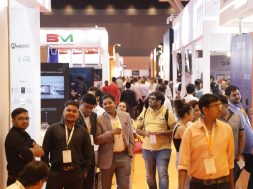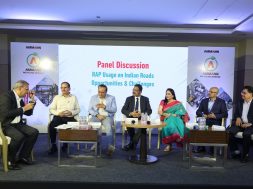Envisaging the concept of making a mark in infrastructure, the world is coming closer through different channels in the form of sea routes and bridges, breaking barriers to offer significant economic growth. Relin Hedly takes a look at the major upcoming projects that could accentuate nation’s growth
Accelerate infrastructure projectsIndia’s rise in the recent years has contributed significantly to the world economy. It has emerged as an important player proportionate to its demographic size. Profound political changes in the Indian economy are contributing towards the growth of the country. With a rise in investment and robust macroeconomic fundamentals, the future outlook for India is distinctly upbeat.
India could unleash its full potentials, provided it improves its infrastructure facilities, which are at present not sufficient to meet the growing demand of the economy. Failing to improve the country’s infrastructure will slowdown India’s growth process. Therefore, Indian government’s first priority should be rising to the challenge of maintaining and managing high growth through investment in infrastructure sector, among others.
Infrastructure development a catalyst to economic growthGood quality infrastructure is a key ingredient for sustainable development. All countries need efficient transport, sanitation, energy and communication systems in order to prosper and provide a decent standard of living for their populations. Unfortunately, many developing countries lack adequate infrastructure, which hampers their growth and ability to trade in the global economy.
Infrastructure and construction projects for the public could help reinforce economic growth. The relationship between the economy and infrastructure is evidently critical to promoting inclusive growth. Infrastructure development supports various kinds of economic activity and also raises the marginal product of other capital used in the production process. This linkage between the economy and infrastructure is multi-dimensional in the sense that, economic growth provides both the need for, and the resources to fund, various types of infrastructure provided that infrastructure projects take place in response to appropriate cost-benefit analysis, such projects promote GDP growth. Alternatively, the failure to provide appropriate infrastructure services may hamper GDP growth by creating bottlenecks and hence opportunities for promoting economic growth could be inhibited.
The country’s economy has spread its wings. However, for it to truly take off, the country has to improve infrastructure. One can speed up the process, by revising, revisiting and upgrading the development plans with a long-term view. Further reforms are the pre-requisite for growth and reforming infrastructure sustains growth.
Growth driversIndia has emerged as a strong economy over the years. The recent global financial and economic crisis had an impact on India’s economic growth momentum during FY09. However, the economy has been remarkably resilient against shocks such as turmoil in the global and domestic financial markets, severe drought conditions and hardening international crude oil prices, sustaining its GDP growth. It has managed to escape relatively unscathed from the global economic turmoil owing to strong fundamentals, which would continue to drive its growth. Thus, it is important to undertake integrated efforts to further strengthen these fundamentals and fulfil the aspiration of achieving a strong growth in future.
Sustained increase in infrastructure is expected to be one of the crucial factors for sustaining strong growth during the current decade. Significant investment in physical infrastructure will also lead to employment generation, increased production efficiency, reduction in cost of doing business and improved standard of living.
Major infra projects that could accentuate growthThe Jaitapur projectNuclear power is considered as one of the best energy in nature to be used in safe condition. The energy comes from the use of sustained nuclear fission to generate heat and electricity. Jaitapur home to the world-famous alphonso mango is a small port situated in Rajapur. It came into limelight due to the proposed Jaitapur Nuclear Power Project by Nuclear Power Corporation of India. The Nuclear Power Plant was approved during the then French President Nicolas Sarkozy’s trip to India in December 2010 thus giving French multinational ‘Areva’ the contract to construct 6 reactors, each of 1650 MW capacity totaling to 9,900 MW. The actual plant site is situated at Madban, a village besides Jaitapur. However, the project has been named after Jaitapur, as it is the port for the project.
Once commissioned, the 9,900 MW Jaitapur Nuclear Power Station will be the largest in the world, overtaking the current largest 8,200 MW Kashiwazaki-Kariwa Nuclear Power Plant in Japan.
HurdlesJaitapur is considered to be prone to seismic activity. Data collected by the Geological Survey of India has suggested that there have been over 92 quakes in 20 years, the biggest of them being 6.2 on the Richter scale. Keeping this in view and the recent Fukushima I nuclear accidents in Japan, massive protests were organised by the locals and the tribes in the area who do not trust the Indian Government of providing them with adequate safeguards and preserving the biodiversity of the region. The 9,900 MW proposed project is pegged to be the biggest in the world. It has already been facing stiff resistance from locals over fears of security and losing their livelihoods after the project comes up.
Both Fukushima and Jaitapur sites are on the coast but with one major difference: while Japan falls in Seismic Zone V, the very high-risk zone for seismic activity, Jaitapur is located in seismic zone III which is the moderate risk zone. The project is being imposed on a beautiful ecosystem, a segment of the Sahyadris where the rivers Krishna and Godavari originate, with a flourishing farming, horticultural and fisheries economy. It lies in one of the world’s 10 greatest biodiversity hotspots. Seismicity is also of concern. Jaitapur is an earthquake-prone area, with a rating of 3 on a 1-5 scale. This violates an official committee’s recommendations against locating hazardous industries outside zone 2.
Jaitapur’s six proposed EPRs were cleared in an extraordinarily sloppy Environment Impact Assessment by National Environmental Engineering Research Institute that has no competence in seismic or nuclear safety-related matters. It evades biodiversity issues and one of the greatest problems with nuclear power – generation and storage of large quantities of radioactive wastes.
Kudankulam Nuclear Power ProjectThe Kudankulam Nuclear Power Project (KNPP) is a nuclear power station situated in Kudankulam in the Tirunelveli district of the southern Indian state of Tamil Nadu & 25 km north-east of Kanyakumari and 35 km from Nagercoil. The plant has been executed with a collaboration between India and Russia. According to Nuclear Power Council of India (NPCIL), the first reactor of 1000 MW power plant is expected to start commercial operation from August and another 1000 MW reactor would be operational by March 2013.
An Inter-Governmental Agreement on the project was signed on November 20, 1988 by Prime Minister Rajiv Gandhi and Soviet President Mikhail Gorbachev, for the construction of two reactors. The project remained in documents for a decade due to the political and economic unstability in Russia after the post-1991 Soviet breakup. There were also objections from the United States, on the grounds that the agreement does not meet the 1992 terms of the Nuclear Suppliers Group demands.
HurdlesNuclear Energy was always a concern for the modern world after the Japan’s Fukushima nuclear disaster. Till now, the Kudankulam nuclear power plant has faced severe agitation, the commissioning put on hold due to the anti-nuclear protests by the locals and People’s Movement Against Nuclear Energy (PMANE). In October 2011, thousands of protesters and villagers living around the Russian-built Kudankulam nuclear plant in the southern Tamil Nadu state, blocked highways and staging hunger strikes, preventing further construction work, and demanding its closure as they fear of the disasters like the environmental impact of nuclear power, radioactive waste, nuclear accident similar to the radiation leak in Japan.
Current statusThe Tamil Nadu government decided that the nuclear power plant in Kudankulam will be commissioned despite prolonged protests from local villagers and the anti-nuclear community since September and announced a ` 500 crore special development package for the area where it is located.
Sethusamudram Ship Channel ProjectThe much anticipated Sethusamudram Ship Channel Project, which envisages dredging of a ship channel across the Palk straits between India and Sri Lanka, is finally taking shape. The project will allow ships sailing between the east and west coasts of India to have a straight passage through India's territorial waters, instead of having to circumvent Sri Lanka. This will lead to saving of up to 424 nautical miles (780 Km) and up to 30 hours in sailing time.
Two channels will be created, one across north of Adam's Bridge (the chain of islets and shallows linking India with Sri Lanka) South – east of Pamban Island and another through the shallows of Palk Bay, deepening the Palk straits. The total length of these two channels would be 89 kms.
Precursor of GrowthThe project will contribute to the national economy, develop the coastal districts of Tamil Nadu, and improve the international competitiveness of India's exports. According to conservative estimates, about 3,055 vessels will be using the canal annually. This will inevitably go up further. India's exports will become globally more competitive. Domestic consumers will also be benefited with industries producing cheaper goods for the domestic market due to cost of raw material imports. It will facilitate coast movement of domestic cargo, leading to greater employment generation in the ports and the industries in the vicinity.
The project is expected to become self-sustaining over a period of time. The substantial benefits will include raise in the national and regional economy. Actual payback period accumulated earnings due to implementation of the fishermen in the coastal districts.A shorter navigation route between Kanyakumari and Tuticorin and other east coast ports of Chennai, Ennore, Kakinada, Visakhapatnam, Paradip, Haldia and Kolkata and ports in neighbouring countries such as Chittagong.
Maritime trade in Tamil Nadu, both coastal and international, will flourish with rapid development of existing minor port in Ramanathapuram. Fishermen will directly benefit due to the potential for development of fishing harbours (between Nagapattinam and Tuticorin) with proper landing and storage facilities. Development of existing major and minor ports and new ports will accelerate industrial development of the hinterlands resulting in huge employment opportunities in manufacturing units and service sectors.
The channel will become an invaluable asset from national defence and security point of view enabling easier and quicker access between the coasts. Indian Coast Guard and Naval ships will not have to circumnavigate around Sri Lanka. Moreover transshipment of Indian Cargo on foreign shores will gradually decrease and after sometime stop altogether.
Delhi Mumbai Industrial Corridor (DMIC)Delhi-Mumbai Industrial Corridor is a mega infra-structure project of USD 90 billion with the financial and technical aids from Japan, covering an overall length of 1483 kms between the political capital and the business capital of India, i.e. Delhi and Mumbai.
This project incorporates nine mega industrial zones of about 200-250 sq. km., high speed freight line, three ports, and six air ports; a six-lane intersection-free expressway connecting the country’s political and financial capitals and a 4000 MW power plant. Several industrial estates and clusters, industrial hubs, with top-of-the-line infrastructure would be developed along this corridor to attract more foreign investment. Funds for the projects would come from the Indian government, Japanese loans, and investment by Japanese firms and through Japan depository receipts issued by the Indian companies.
VisionThe vision for DMIC is to create strong economic base with globally competitive environment and state-of-the-art infrastructure to activate local commerce, enhance foreign investments and attain sustainable development. Delhi -Mumbai Industrial Corridor is to be conceived as a Model Industrial Corridor of international standards with emphasis on expanding the manufacturing and services base and develop DMIC as the ‘Global Manufacturing and Trading Hub’.
The developmental planning for DMIC aims to achieve certain end results with implementation that would ensure realisation of envisaged vision for the project and lead to economic development. Accordingly the project goals for DMIC are:• Double employment potential in five years (14.87 per cent CAGR)• Triple industrial output in five years (24.57 per cent CAGR)• Quadruple exports from the region in five years (31.95 per cent CAGR)
Nhava Sheva Sea LinkOwing to ever increasing congestion on the existing rail and road corridors coupled with limitation of further expansion on these corridors, there is a need to expand the city on the mainland across Arabian Sea by providing additional access from Mumbai to mainland at South Navi Mumbai.
The development initiatives proposed in the Southern Navi Mumbai region will not only give rise to additional traffic movement but also accentuate the need for greater economic integration of Mumbai with mainland. The proposed economic activities taken up for development in the southern Navi Mumbai are:• International airport at Navi Mumbai• New container terminals at Jawaharlal Nehru Port Trust at Nhava Sheva • Navi Mumbai SEZ (NMSEZ)• Maha Mumbai SEZ (MMSEZ).
The proposed additional access i.e. Mumbai Trans Harbour Link (MTHL) connecting Sewri (Mumbai end) to Nhava Sheva (Navi Mumbai end) is expected to be catalyst of development of the city by promoting horizontal growth as against the vertical growth experienced over the past few years. The link will help reduce the problems of congestion and pollution in Mumbai.
The Mumbai Trans Harbour Link (MTHL) is proposed to be developed as an expressway link with a six-lane dual carriageway road bridge and rail bridge connecting Sewri on Mumbai side to Nhava on Navi Mumbai side. The MTHL project is proposed to commence at grade from the east side of Sewri railway station on the harbour line of central railway proceed to Nhava and terminate at the north of Chirle village with an interchange to National Highway 4B on the mainland.
India Myanmar Thailand Highway to be ready by 2016 India to open a new 4-lane roadways to connect North-East part of the country with Myanmar, Thailand, and eventually Cambodia and Vietnam.
The new 'trilateral highway' is aimed at creating a new economic zone ranging from Kolkata on the Bay of Bengal to Ho Chi Minh City on the South China Sea.
The first phase of the project was agreed with a 2016 deadline to complete a super highway linking Guwahati in Assam to Burma's border with Thailand via Mandalay and the former capital Rangoon.
For India, the new highway will open up new oil and gas opportunities off the coast of Burma, and also Vietnam, as well as easier access to Japanese products made in Thailand. It would also bring new wealth to its poor and marginalised North-Eastern states like Manipur and Nagaland, which have been destroyed by local insurgencies and heavy security. The highway will also recall the historic ties between India and Burma which unravelled following their independence from Britain after the Second World War.
The idea is that one can get in a car or bus and drive to Bangkok from Guwahati. Burma was the hurdle, but now it has opened up and marks a great opening of a new economic zone. Once accomplished, the project will allow traders and tourists to drive from Assam into Myanmar and Thailand.
Cookie Consent
We use cookies to personalize your experience. By continuing to visit this website you agree to our Terms & Conditions, Privacy Policy and Cookie Policy.









